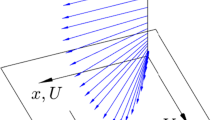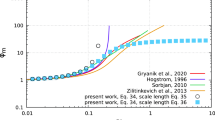Abstract
A new approach to the classical closure problem for turbulent boundary layers is presented. This involves using the well-known mean-flow scaling laws such as Prandtl’s law of the wall and the law of the wake of Coles together with the mean continuity and the mean momentum differential and integral equations. The important parameters governing the flow in the general non-equilibrium case are identified and are used for establishing a framework for closure. Initially, closure is done here empirically from the data but the framework is most suitable for applying the attached eddy hypothesis in future work. How this might be done is indicated here.
Similar content being viewed by others
References
Bradshaw P, Ferriss D 1965 The response of a retarded equilibrium boundary layer to the sudden removal of pressure gradient. Technical Report 1145 NPL Aero. Report
Clauser F H 1954 Turbulent boundary layers in adverse pressure gradients.J. Aero. Sci. 21: 91–108
Clauser F H 1956 The turbulent boundary layer.Adv. Mech. 4: 1–51
Coles D E 1956 The law of the wake in the turbulent boundary layer.J. Fluid Mech. 1: 191–226
Coles D E 1957 Remarks on the equilibrium turbulent boundary layer.J. Aero. Sci. 24: 459–506
Coles D E 1962 The turbulent boundary layer in a compressible fluid. USAF The Rand Corporation, Rep. R-403-PR, Appendix A. See also: (1964)Phys. Fluids 7: 1403–23
East L F, Sawyer W G, Nash C R 1979 An investigation of the structure of equilibrium turbulent boundary layers. RAE Tech. Report 79040
Jones M B 1998The structure of sink flow turbulent boundary layers. Ph D thesis, University of Melbourne, Australia
Lewkowicz A K 1982 An improved universal wake function for turbulent boundary layers and some of its consequences.Z. Flugwiss. Weltraumforsch. 6: 261–266
Ludwieg H, Tillmann W 1949 Investigations of the wall shearing stress in turbulent boundary layers. Technical Report NACA TM 1285
Marusic I 1991The structure of zero- and adverse-pressure gradient turbulent boundary layers. Ph D thesis, University of Melbourne, Australia
Marusic I, Perry A E 1995 A wall-wake model for the turbulence structure of boundary layers. Part 2. Further experimental support.J. Fluid Mech. 298: 389–407
Perry A E, Marusic I 1995 A wall-wake model for the turbulence structure of boundary layers. Part 1. Extension of the attached eddy hypothesis.J. Fluid Mech. 298: 361–388
Perry A E, Marusic I, Li J D 1994 Wall turbulence closure based on classical similarity laws and the attached eddy hypothesis.Phys. Fluids 2: 1024–1035
Rotta J C 1962 Turbulent boundary layers in incompressible flow.Prog. Aero. Sci. 2: 1–219
Skåre P E, Krogstad P-Å 1994 A turbulent boundary layer near separation.J. Fluid Mech. 272: 319–348
Townsend A A 1976The structure of turbulent shear flow (Cambridge: University Press) vol. 2
White F M 1974Viscous fluid flow (New York: McGraw-Hill)
Author information
Authors and Affiliations
Rights and permissions
About this article
Cite this article
Perry, A.E., Marusic, I. & Jones, M.B. New evolution equations for turbulent boundary layers in arbitrary pressure gradients. Sadhana 23, 443–457 (1998). https://doi.org/10.1007/BF02744574
Issue Date:
DOI: https://doi.org/10.1007/BF02744574




